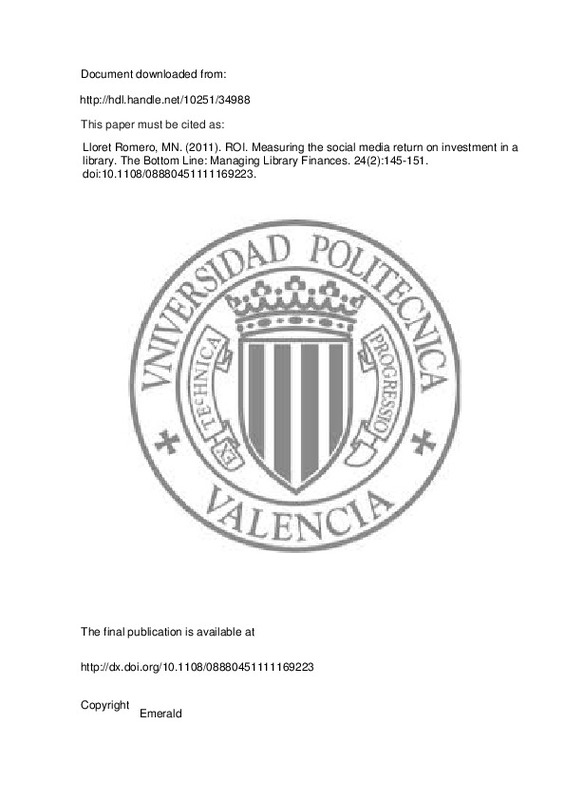JavaScript is disabled for your browser. Some features of this site may not work without it.
Buscar en RiuNet
Listar
Mi cuenta
Estadísticas
Ayuda RiuNet
Admin. UPV
ROI. Measuring the social media return on investment in a library
Mostrar el registro sencillo del ítem
Ficheros en el ítem
| dc.contributor.author | Lloret Romero, María Nuria
|
es_ES |
| dc.date.accessioned | 2014-01-21T11:23:33Z | |
| dc.date.issued | 2011 | |
| dc.identifier.issn | 0888-045X | |
| dc.identifier.uri | http://hdl.handle.net/10251/34988 | |
| dc.description.abstract | Purpose: In all projections for 2011, ROI has become of the great challenges of social media marketing for the business environment. However in the case of non-profit organizations, there is no need for such calculations. It is not as necessary to know how the effort made in these media compares to the benefits that can be obtained. This paper aims to compare the parameters governing social media ROI at an enterprise level and at the level of non-profit institutions. Additionally, the use of social media tools in a strategic plan and to save costs in the institution is discussed. Design/methodology/approach: Where ROI is defined as a mere indicator of return on investment, it involves the direct costs and revenues of each transaction. Combining the world of social media marketing, which is full of intangibles, with the current crisis makes knowing "real" return one of the greatest current needs. When demanding returns from institutions that have never been analyzed from this standpoint, it is important to understand how a tool like this can be used to justify an entity's visibility, brand improvement and ultimately, an increase in the institution's quality and use by users. Also, it should be taken into account that while in 2010 branding was the primary goal of communication in social media, this year in view of the increasingly endemic crisis, a ROI analysis can help an institution to evidence how the cost savings inherent in using these as opposed to former marketing tools substantiate their use. However, this interest involves a great risk of simplification. Findings: The analysis used to measure ROI can follow these lines: The consumption by previous users can be compared with that of current arrivals on the network. Comparisons can be made between the behavior of a user prior to following the library on social media and after doing so. The extent to which the success of new developments, events etc. has improved after being communicated in social networks can be measured. The influence of brand perception on users' consumption and the extent to which the new media have changed this perception can be measured. Originality/value: Conducting a ROI analysis of a library's social media marketing campaign can help it evaluate various aspects in the library. Social media can be considered as an interesting information dissemination tool requiring only minimal effort which can be used by the library to promote reading and publicize its informational and cultural efforts. Social media can also be used as dynamic, provision of service and marketing resources with a clear reduction in costs compared to other more traditional types of advertising and publicizing. Given that in the management of these tools, it is the contents and ideas that are essential rather than the economic resources available, social media are particularly useful for small and medium libraries as they provide the possibility of increasing the visibility of the institution and improving its service and its users' experience. Opening a new channel of communication with users on the internet is a challenge for libraries that can be optimized with the development of a strategy for the use of social media. The library should make an effort to manage these resources efficiently and obtain the largest possible return on their use. © Emerald Group Publishing Limited. | es_ES |
| dc.format.extent | 7 | es_ES |
| dc.language | Inglés | es_ES |
| dc.publisher | Emerald | es_ES |
| dc.relation.ispartof | The Bottom Line: Managing Library Finances | es_ES |
| dc.rights | Reserva de todos los derechos | es_ES |
| dc.subject | Library 2.0 | es_ES |
| dc.subject | Marketing | es_ES |
| dc.subject | Public libraries | es_ES |
| dc.subject | Return on investment | es_ES |
| dc.subject | ROI | es_ES |
| dc.subject | Social media | es_ES |
| dc.subject | Social networking websites | es_ES |
| dc.subject | Tools 2.0 | es_ES |
| dc.subject.classification | BIBLIOTECONOMIA Y DOCUMENTACION | es_ES |
| dc.title | ROI. Measuring the social media return on investment in a library | es_ES |
| dc.type | Artículo | es_ES |
| dc.embargo.lift | 10000-01-01 | |
| dc.embargo.terms | forever | es_ES |
| dc.identifier.doi | 10.1108/08880451111169223 | |
| dc.rights.accessRights | Abierto | es_ES |
| dc.contributor.affiliation | Universitat Politècnica de València. Departamento de Comunicación Audiovisual, Documentación e Historia del Arte - Departament de Comunicació Audiovisual, Documentació i Història de l'Art | es_ES |
| dc.description.bibliographicCitation | Lloret Romero, MN. (2011). ROI. Measuring the social media return on investment in a library. The Bottom Line: Managing Library Finances. 24(2):145-151. doi:10.1108/08880451111169223 | es_ES |
| dc.description.accrualMethod | S | es_ES |
| dc.relation.publisherversion | http://dx.doi.org/10.1108/08880451111169223 | es_ES |
| dc.description.upvformatpinicio | 145 | es_ES |
| dc.description.upvformatpfin | 151 | es_ES |
| dc.type.version | info:eu-repo/semantics/publishedVersion | es_ES |
| dc.description.volume | 24 | es_ES |
| dc.description.issue | 2 | es_ES |
| dc.relation.senia | 216253 | |
| dc.description.references | Gómez Pereda, N. and Merlo Vega, J.A. (2010), “Experiencias bibliotecarias con las tecnologías sociales: dossier”, Educación y biblioteca, Vol. 177, pp. 58‐125. | es_ES |
| dc.description.references | Zarabozo, A. (2008), “Blogs y bibliotecas”, Biblioasturias, No. 11, pp. 10‐12. | es_ES |







![[Cerrado]](/themes/UPV/images/candado.png)

